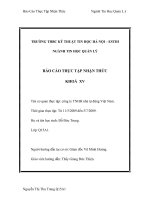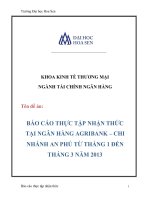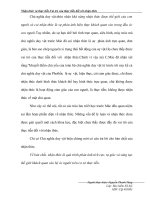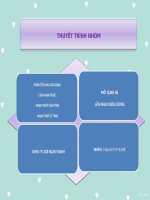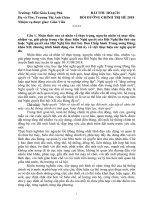A study on vietnamese teachers perceptions on teaching english as a foreign language to preschool children = nghiên cứu về nhận thức của giáo viên việt nam về việc dạy tiếng anh như một ngoại ngữ cho trẻ mầm non
Bạn đang xem bản rút gọn của tài liệu. Xem và tải ngay bản đầy đủ của tài liệu tại đây (707.21 KB, 81 trang )
MINISTRY OF EDUCATION AND TRAINING
QUY NHON UNIVERSITY
LÊ VÂN ANH
A STUDY ON
VIETNAMESE TEACHERS’ PERCEPTIONS ON
TEACHING ENGLISH AS A FOREIGN LANGUAGE
TO PRESCHOOL CHILDREN
Field: Theory and Methodology of English Language Teaching
Code: 8140111
Supervisor: Assoc-Prof. Ton Nu My Nhat
BỘ GIÁO DỤC VÀ ĐÀO TẠO
TRƢỜNG ĐẠI HỌC QUY NHƠN
LÊ VÂN ANH
NGHIÊN CỨU VỀ NHẬN THỨC CỦA GIÁO VIÊN VIỆT NAM
VỀ VIỆC DẠY TIẾNG ANH NHƢ MỘT NGOẠI NGỮ
CHO TRẺ MẦM NON
Ngành: Lý luận và phƣơng pháp dạy học bộ môn tiếng Anh
Mã số: 8140111
Ngƣời hƣớng dẫn: PGS.TS. Tôn Nữ Mỹ Nhật
i
ACKNOWLEDGEMENTS
First, I would like to express my gratitude to the English teachers to
young learners in Binh Dinh province and other provinces in Vietnam who
participated in this study. Without their participation, this study would not
have been accomplished.
I am enormously grateful to my supervisor, Assoc-Prof. Ton Nu My
Nhat, for her excellent guidance, support, patience, and her invaluable
assistance. She has always been available to support me not only
academically but also spiritually.
I would also like to thank the lecturers of English, Department of
Pedagogy, Quy Nhon University, for their support and guidance throughout
the research process.
The writing of this thesis owes a great deal to the support of others. I
would like to thank to Mr. Le Phu Nguyen, Mr. Truong Minh Vuong, Ms
Huynh Thi Hong Gam, Ms. Dao Nguyen Huong and Ms. Huynh Thi Kim
Hoa for their emotional support and companionship.
I dedicate this thesis to my father Mr. Le Phi Van, my mother Mrs. Pham
Thi Tuyet Suong, my brother Mr. Van Chinh, my aunt Ms. Pham Thi Suong
Sa and the other members of my extended family, who have always been
there and prayed for me. I cherish them more than anything.
Le Van Anh
ii
TABLE OF CONTENTS
ACKNOWLEDGEMENTS .............................................................................. i
TABLE OF CONTENTS ................................................................................. ii
ABSTRACT .................................................................................................... iv
LIST OF TABLES ........................................................................................... v
LIST OF ABBREVIATIONS ......................................................................... vi
LIST OF FIGURES ........................................................................................ vii
CHAPTER 1. INTRODUCTION ..................................................................... 1
1.1. Rationale .............................................................................................. 1
1.2. Aims and objectives ............................................................................... 2
1.2.1. Aim ................................................................................................... 2
1.2.2. Objectives ......................................................................................... 2
1.3. Research question ................................................................................... 3
1.4. Significance of the study ...................................................................... 3
1.5. Scope of the study ................................................................................ 3
1.6. Design of the study ................................................................................. 4
CHAPTER 2. LITERATURE REVIEW .......................................................... 5
2.1. Theoretical background .......................................................................... 5
2.1.1. Learning a foreign language at an early age .................................... 5
2.1.2. The characteristics of children as young learners of EFL ................ 8
2.1.3. TEFL to young learners.................................................................... 9
2.1.4. The challenges of TEFL to YLs ..................................................... 16
2.2. Previous studies relevant to the present study ...................................... 18
CHAPTER 3. RESEARCH METHODOLOGY ............................................ 23
3.1. Research design .................................................................................... 23
3.2. Participants ........................................................................................... 24
3.3. Data collection ..................................................................................... 26
iii
3.3.1 The questionnaire ............................................................................ 26
3.3.2. The interview.................................................................................. 28
3.4. Data analysis...................................................................................... 269
SUMMARY ................................................................................................ 29
CHAPTER 4. FINDINGS AND DISCUSSION ............................................ 31
4.1. The necessity for EFL to be taught to preschool children .................... 31
4.2. Benefits of TEFL to YLs ...................................................................... 37
4.3. The challenges faced by teachers face in teaching EFL to children..... 40
4.4. The teachers‟ suggestions ..................................................................... 44
SUMMARY ................................................................................................ 48
CHAPTER 5. CONCLUSION AND IMPLICATIONS ................................ 50
5.1. Summary of findings ............................................................................ 50
5.2. Implications .......................................................................................... 52
5.4. Limitations and suggestions for further studies ................................... 53
REFERENCES ............................................................................................... 55
APPENDIXES
iv
ABSTRACT
It has been nearly a decade since English was officially taught to third
graders in primary schools in Vietnam. This decision has indirectly impacted
the unstoppable trend of having the preschool children learn this foreign
language at kindergartens or/and foreign language centers as a head-start.
This study sought to capture the teachers' perceptions of teaching English as a
foreign language to preschool children. The specific research questions are:
(1) To what extent is it necessary to teach English to very young learners in
the context of Vietnam? (2) What are the benefits of teaching EFL to very
young learners in the context of Vietnam? (3) What are the challenges faced
by the teachers when teaching EFL to very young learners in the context of
Vietnam? and (4) What suggestions can be made on improving the
effectiveness of teaching English to very young learners in the context of
Vietnam? To address the questions aimed at, this study employed the mixed
methods research design: the quantitative data was obtained through the
questionnaires and the qualitative data was obtained through the open-ended
focused interviews. The participants were forty-three teachers of English at
the kindergartens in Binh Dinh and other provinces in Vietnam. The results
showed that the teachers generally agreed with the idea of introducing
children to English at an early age. Their agreement with the actual
curriculum used for that purpose was considerably weaker. The benefits
articulated were mostly in agreement with those in literature; however, the
challenges mentioned showed features constrained by the social and
educational background of Vietnam. Based on the results, a number of
practical implications were drawn.
v
LIST OF TABLES
Table 3.1 The participants‟ background information.
Table 3.2 Description of the questionnaire in term of clusters.
Table 4.1 Teachers‟ perceptions on the necessity of TEFL to YLs.
Table 4.2 Teachers‟ perceptions on the benefits of TEFL to YLs
Table 4.3 Challenges faced by English teachers to YLs
vi
LIST OF ABBREVIATIONS
TEFL: Teaching English as a Foreign Language
YLs: Young Learners
VYLs: Very Young Learners
ELT: English Language Teaching
EFL: English as a Foreign Language
vii
LIST OF FIGURES
Figure 3.1. The participants‟ workplace information.
Figure 3.2. The participants‟ years of English teaching information.
Figure 4.1. Teachers‟ perceptions on the necessity of TEFL to YLs.
1
CHAPTER 1
INTRODUCTION
1.1. Rationale
In the national educational system in Vietnam, English is one of the main
subjects in the curriculum throughout different levels. It is also one of the five
subjects required for the national final examinations. Despite the fact that the
inclusion of English as a compulsory subject does not exclude students from
studying other languages such as Russian, French, Chinese, Japanese, or German
especially in big cities, English has been widely acknowledged as the most
popular and vital foreign language taught in Vietnam at all levels of school.
Pursuant to Decision No. 1400/QD-TTg dated September 30, 2008, of
the Prime Minister, the National Foreign Language Project 2020, now 2025,
states "by 2020, complete the promulgation of the elective foreign language
program for grades 1 and 2. By 2025, strive for 100% of students from grades
3 to 6 to study a foreign language program for 10 years (starting from grade
3 to grade 12)". English was a compulsory subject from grade 3 with the
number of 4 periods/week from 2018 and was made a required subject in all
examinations.
However, in our rapidly globalizing society, many parents desire that
their children begin learning English in kindergarten. Over time, foreign
language centers and kindergartens in Vietnam have introduced English as a
foreign language (EFL) to teach to children, so learning English at a very
young age has become quite common in Vietnam.
Of the factors to sustain efficiency in education, the teacher represents
one of the most crucial. They must meet stringent qualifications to teach a
foreign language to children. Teachers' perspectives have a huge impact on
2
both what and how to teach. Teachers' views of their students, instructional
techniques, and teaching content are all affected by their principles and
objectives. Perception refers to a belief or opinion, often held by many people
and based on how things seem. As a result, teachers‟ perceptions might be
defined as a teacher's belief, opinion, or attitude toward something. According
to Heather and Carey (2009), cited in Xu (2012), teachers' attitudes can
influence their instructional practice. As a result, teachers' views frequently
influence judgments about teaching methods, and they can also have a direct
impact on their students' attitudes toward learning, which are often formed
early in life. Those theoretical and practical implications have inspired me to
carry out “A study on Vietnamese Teachers’ Perceptions on Teaching English
as a Foreign Language to Preschool Children”.
1.2. Aims and objectives
1.2.1. Aim
The aim of this study was to look into Vietnamese teachers'
perspectives on teaching English as a foreign language (TEFL) to preschool
children given the social, cultural and educational background of Vietnam.
1.2.2. Objectives
Given the above overarching aim, this study is going to
(1) Investigate the EFL teachers‟ perspectives on whether it is necessary for
EFL to be taught to preschool children.
(2) Investigate the EFL teachers‟ perspectives on the advantages of EFL
education for preschoolers.
(3) Investigate the EFL teachers‟ perspectives on the difficulties they
encounter when teaching EFL to preschool children.
(4) Investigate the teachers' recommendations for enhancing the efficiency of
TEFL for preschoolers.
3
1.3. Research question
Based on these above aims, the research questions are:
(1) Is it necessary for EFL to be taught to preschool children?
(2) What are the benefits of teaching EFL to preschool children?
(3) What are the challenges faced by the teachers when teaching EFL to
preschool children?
(4) What are the teachers‟ suggestions on improving the effectiveness of
TEFL to preschool learners?
1.4. Significance of the study
Given the widespread and increasing needs of TEFL to preschool
learners in Vietnam, there has been very little research into this issue. This
gap can be attributed to the fact that, as mentioned earlier, in the Vietnamese
educational system, it is not until the third grade that EFL is officially taught.
A study of Vietnamese teachers' perspectives on TEFL to preschool children
could inform the stakeholders of the pertinent issues concerning this
widespread practice – the needs, the perceived benefits and the challenges
faced by these practitioners. In addition, the findings of this study could serve
as a reference for other educational contexts which are similar to the that of
this study.
1.5. Scope of the study
Young learners are theoretically divided into three categories based on
their age and grade level (Ersoz, 2007). The first group consists of very young
learners (VYLs), aged 3-6, followed by young learners (YLs), aged 7-9, and
older/later young learners (aged 10). This study is concerned with TEFL to
learners before they attend grade 3 in Vietnamese primary schools and thus
focuses on only the first group, although they may variously be referred to as
„children‟, „preschool learners‟, „young learners‟, or „very young learners.
Then, the participants in the study were mostly female teachers from
4
public kindergartens and English centers in Binh Dinh, with a limited number
from some other provinces in Vietnam, as indicated in 3.2.
1.6. Design of the study
The study is structured as follows:
- Chapter 1, Introduction, states the rationale, aim and objectives of the
study, significance, scope of the study and design of the thesis.
- Chapter 2, Literature review, presents the theoretical issues which
shed light on this study and the previous studies on TEFL to children.
- Chapter 3, Methodology, describes the research methods, the
participants involved in the study, the data-gathering instruments, and data
collection procedure.
- Chapter 4, Findings and Discussion, unfolds the results revealed from
the two sets of data – quantitative and qualitative. Also, it discusses the
results, interpreting them and comparing them with those of the previous
relevant studies.
- Chapter 5, Conclusion, exhibits a summary of the findings, some
limitations and some pedagogical suggestions for TEFL to VYLs in Vietnam.
It also puts forward some suggestions for further studies.
5
CHAPTER 2
LITERATURE REVIEW
This chapter presents the theoretical issues which shed light on the
investigation. It begins with a description of the viewpoint: “the Younger, the
Better” by the two most relevant theories concerned with language education
to YLs are summarized - Theory of Language Development and Critical
Period Hypothesis. The chapter continues with the characteristics of children
as YLs of English as a foreign language and teaching English as a Foreign
Language to children. The chapter continues with an emphasis on
methodology, paying specific attention to activities, teaching resources, and
approaches. The final section provides an account of the previous studies
closely related to this study
2.1. Theoretical background
2.1.1. Learning a foreign language at an early age
As regards the question of „when to start‟, there seems to be a
widespread belief that the younger to start, the better it is for the learners.
Morford and Mayberry (2000) note that individuals who are exposed to
language at a younger age typically outperform those who are not. According
to Palea and Boştină-Bratu (2015), it appears that the decline in the ability to
learn a foreign language is correlated with age. The theories which are closely
related to this idea are Theory of Language Development and Critical Period
Hypothesis.
According to Theory of language development, language learning is not
something that the child does; it is something that happens to the child when
placed in an appropriate environment, much like the child's body grows and
matures in a predictable manner when provided with appropriate nutrition and
environmental stimulation (Chomsky, 1988). Young children demonstrate
6
development in their phonics and semantics throughout this stage, and they
can express themselves verbally. However, their grammar is incorrect, their
pronunciation may be shaky, and their ability to mix many words is restricted.
Because this is when their cognitive functioning is equipped to perform such
tasks, ideas such as word problems, mathematics, and writing are created
throughout these years (Lightfoot, Cole & Cole, 2008). As a result, there is a
unique chance to introduce children to a foreign language during the late
preoperational stage, when they are still learning the fundamentals of their
first language. They are still at a stage where they do not comprehend the
structure of the language beyond a small number of words to which they have
been exposed (Lightfoot, et al., 2008). Because their minds are free of the
difficulties that arise when the entire structure of one language is cemented in
one's memory, students in the late stages of their preoperational stage have the
potential to both better understand and develop skills in their native language
while also beginning to learn another.
The “Critical Period Hypothesis” (CPH) refers to children's ability to
quickly learn a new language. The CPH is based on a biological concept of
second language acquisition that is based on the assertions of Penfield and
Roberts (1959) and further developed by Lenneberg (1967). For Lenneberg
(1967), the ability to acquire foreign languages continues throughout puberty,
but it tends to decline. Furthermore, natural acquisition of a language from
simple exposure appears to fade after this age, and foreign languages must be
taught and learned through a conscious and laborious effort. The word
“lateralization” was coined by Lenneberg (1967, p.176) to describe a period
when the localization of language-processing abilities in the human's left
hemisphere was associated with biological change/development. The critical
period is a physiologically set period of life, primarily around puberty, when a
language can be acquired most quickly, but if it is beyond this point, mastery
7
becomes difficult. During the critical period, learning a language occurs
naturally through extensive exposure to it without formal instruction; as a
result, learning occurs unconsciously and fast (Ahmed, 2008). Scovel (1988)
defines a critical period as the critical period theory holds that language is
best learnt during the early years of childhood, and that beyond around the
first twelve years of life, everyone experiences certain restrictions in their
ability to learn a new language. This viewpoint holds that as young children
get older, changes in the brain occur, making it difficult for languages to be
learned naturally as they are in the early years. Educators commonly believe
that pupils who have reached puberty will be unable to achieve native speaker
levels of proficiency, particularly in terms of pronunciation and intonation.
Despite its complexity, the Critical Period Hypothesis can be used to
explain the relationship between success in English language learning and
age. This phase is characterized as the time when a kid may learn a new
language more accurately, simply, and quickly without the need for much
teaching. this period indicates that a student's eventual success in a second
language is substantially controlled by the age at which the student is initially
exposed to the language. If this idea is right, it strongly recommends that
second language acquisition should begin in primary school, possibly even
kindergarten (Du, 2010).
Educators and practitioners have indicated multiple advantages of
learning a foresign/second language at an early age. According to Pan (1997,
as cited in Chuang, M., 2001), YLs are able to study two languages at the
same time without experiencing inter-lingual interference. Children's listening
and speaking skills are greater to adults. It is possible that learning a second
language earlier will have no effect on their first language. They are also good
mimics of sound and intonation patterns, which aids their learning of foreign
languages.
8
Most significantly, a favorable experience can build children's
confidence in language acquisition and positive attitudes/motivation toward
the EFL in the future, allowing them to continue learning English into high
school and beyond. Children are eager to learn new things and are
enthusiastic about doing so. This encourages children to learn new languages
and memorize new words. Moreover, EFL can help to widen children's
cultural horizons and develop intercultural understanding. It can help children
comprehend their mother tongue better and improve the study of other
languages by making them more aware of language as a phenomenon in and
of itself. Learning EFL necessitates the development of new learning
processes. In Piaget's theory, being exposed to “foreignness”, anything new
and unusual, causes a cognitive conflict and can act as a stimulant for
cognitive growth (Curtain, 1990).
2.1.2. The characteristics of children as young learners of EFL
Adults and teenagers learn quicker in the early phases of second/foreign
language development, but if young children are exposed to the language in
situations where they are consistently exposed to it, they eventually catch up
and even surpass them. To put it another way, adults and adolescents learn
faster, yet children surpass adults and adolescents in terms of ultimate
achievement. Teaching children is a delicate and sensitive undertaking.
Among the various characteristics pointed out in the literature (Donaldson
1978; Hughes 1986; Lightbown & Spada 1993; Hashemi & Azizinezhad
2011; Harmer 2001; ...), the following are most critical as far as learnig and
teaching a foreign language is concerned.
+ Short attention span: As young learners have a lot of energy but little
concentration, it is best to involve them in physical activities that take place in
a solid context. They employ all their senses to perceive everything around
them (Lightbown & Spada 1993; Vanessa & Sheila, 1997).
9
+ The "silent period": It is necessary for language teachers to realize that
young children may absorb language for a long time before producing
anything. Even if children do not express themselves, they will be taking
everything in (Vanessa & Sheila, 1997).
+ Having a strong receptive ability: young learners get comprehension
not only through explanation but also from what they see, hear, and learn
when they can touch and interact with objects. Children have a very strong
receptive ability; they can receive knowledge not only from adults, but also
from their peers and everything else in their surroundings (Hamer, 2001).
+ Learn things through playing: For them, learning new words or phrases
is incidental rather than a conscious effort. They enjoy mimicking, making
silly noises, and playing with language sounds. Similar to how they learn L1,
they acquire English by exposure to a lot of it. When exposed to a lot of
English in context, their grammar will gradually improve on its own.
(Slatterly, 2001)
2.1.3. TEFL to young learners
According to Vanessa and Sheila (1997), teaching children in the
preschool age group has several advantages. One of the biggest advantages
for the teacher is that there are usually no rigorous syllabuses to follow, no
assessments to take, and no performance goals to achieve. They are
inquisitive
about
everything,
eager
to
learn,
and
open
to
new
experiences. Obviously, teaching extremely young children comes with its
own set of challenges. They are ready to imitate and join in all activities in
class. It would be more special if it was a group activity with other kids.
However, they place a premium on independence and expect to be treated
with respect and given undivided attention. They can be egotistical and
unwilling to work together (Hashemi & Azizinezhad, 2011). Some of them
will throw tantrums to get their wish even potentially screaming or biting.
10
Some children may require assistance going to the bathroom, and
incontinence may cause accidents. Therefore, it is easy to find that teaching
young kids necessitates highly qualified teachers with a thorough
understanding of learning approaches.
Cameron (2003) states that a language teacher for young learners must
be able to teach basic English reading and writing, and he or she must have
ability and comprehension of spoken English sufficient to conduct entire
classes verbally. Moreover, it is important to understand how children think,
learn, and their enthusiasm for language. It is not simple to teach English to
young children. But if we already know how to accomplish it, it is also not
difficult.
2.1.3.1. Activities
As for activities, according to Harmer (2001), adults and children learn
in various ways. It is easy for children to lose interest in whatever it is that
they are doing. In order to involve children, it is advisable to use a lot of
brightly colored graphics and toys, puppets, or other objects to keep them
interested.
Cooper (2007) classifies language-learning activities for YLs into six
main types that children enjoy in order to make learning engaging and
motivating for children, especially giving YLs the want and need to
communicate:
Using stories: Story is an important way to help YLs develop their
language skills. Young children benefit from book-reading and story-telling
experiences in a variety of ways. However, when selecting and using books, it
is critical to think about solutions and adaptations to meet the requirements of
children.
Using songs and rhymes: Children would enjoy anything with music or a
beat, so using this to teach them vocabulary and linguistic skills is useful. Not
11
all songs or chants to be taught must be useful or classroom-related;
sometimes the use of a meaningless song or rhyme is just having fun.
Art and craft activities: Allowing students to participate in the creation of
lesson-related images involves them in the learning process by introducing
them to the context and key vocabulary terms. Arts and crafts are an excellent
technique to assist language development as well as a variety of other vital
skills for young students. They make a class more engaging and enjoyable;
they also assist in the formation of good associations with a new language.
Games: Games can be a very effective educational tool. A game is
successful if it is engaging and has clear relation to the topic under focus. The
learners' enjoyment is enhanced via their actively engaging with the language.
Role-plays: Role plays are used to allow students to practice speaking in a
conversational situation, build confidence and fluency, assess progress, and
put learning into action. It always helps if students are enjoying themselves.
Role plays do not have to be deadly serious affairs, but as teachers can get
more out of them if they approach them seriously and tie them in to broader
lesson goals.
Routines: Learning routines are established procedures and patterns of
behavior to educate children and then employ frequently and repeatedly for
carrying out ordinary classroom activities. Learning routines have a good
impact on children's learning, behavior, participation, and social and
emotional well-being, as well as on teachers‟ ability to manage their classes
efficiently and produce successful teaching and learning outcomes.
2.1.3.2. Teaching materials
In terms of materials, teachers can take advantage of the learning
materials that are available. However, EFL teachers are encouraged to create
their own learning resources in order to satisfy the needs of their students. To
12
meet the needs of learners, learning resources should provide learners with
opportunities to interact with authentic English through spoken and written
texts (Richards and Schmidt, 2002; Tomlinson, 1998).
Scott and Ytreberg (1990) classified learning materials into three
groups: materials that teachers and children create during the lesson, materials
purchased, and materials collected. The first group is materials for the teacher
and children to create, such as puppets, class mascot, paper dolls, English
corner, cardboard boxes, picture cards, card games, board games,
word/sentence
cards,
word
card
displays,
books,
reading
cards,
transparencies, calendar, clock. The second group is materials to purchase. It
includes maps, wall charts, toys, and construction pieces. The last group is the
materials to be collected. They are those children can find from the variety of
materials that would otherwise be discarded. These are items that can be used
to make collages, puppets, decorate pictures/boxes, go shopping, tell stories,
count, act, mime, and so on; the list is limitless. Yogurt cartons, diverse
ribbons, old cards, postcards, cotton reels, various paper wallpaper stamps,
coins, buttons, twine, jars, various empty packages, bits of material, tissue
paper, and old wrapping paper can all be collected by the teacher. Lessons
will be easier and more enjoyable for the children if teachers use artifacts and
objects in addition to language to conduct their lessons. It is fantastic that
combining handcrafted and factory-made things will be an amazing technique
for teaching English to children in a manner like how children learn their
mother tongue.
2.1.3.3. Methods
Using a variety of methods in the classroom allows the teacher to be
more effective and interesting.
Total Physical Response (TPR)
This is a strategy developed by James Asher (1977) of San Jose State
13
University in California. It is a good way to reinforce excellent English
teaching approaches for preschoolers. As the teacher gives a sequence of
directions or commands, the children pay attention and physically respond.
Richards and Rodgers (1986) noted that TPR is a language teaching
approach that focuses on the synchronization of speech and action; it aims to
teach language through physical activity. Therefore, the more enjoyable the
activities, the more likely YLs are to retain the linguistic information.
Engaging students in creating images or realia may make learning more
engaging. Furthermore, Richard and Rodgers (1986) maintained that the
method is an umbrella term for the formulation of theory and practice
interrelationships. A lesson's visuals created by youngsters can assist pupils
learn by introducing them to context and relevant terminology.
According to Putri (2016), the method has distinct advantages and
disadvantages. First, regarding the benefits of the method, this method is
enjoyable and simple. It does not necessitate extensive preparation on the part
of the teacher. TPR is an effective tool for children to acquire vocabulary.
Class size does not have to be an issue and there is no age limit. It is
beneficial for kinesthetic learners. TPR has several benefits that make it ideal
for educating youngsters, but it also has some drawbacks. It is unlikely to be a
creative way. Students are not given the opportunity to express their own
opinions and ideas in a creative manner. TPR is easily overused by teachers.
The method is limited since this method cannot explain everything. It must be
used in conjunction with other approaches. In addition, this method is difficult
for shy students. It is just suitable for young and very young learners
(Fadillah, 2011).
TPR has been found to be the most effective method for instructing YLs.
This method requires little preparation for the teacher to use in the teaching
learning process. It is beneficial for developing students' listening and
14
speaking skills, as well as extending their vocabularies.
Direct Method
The direct method, also known as the conversational method or natural
method, was developed by Berlitz (1852- 1921) towards at the end of the 19th
century. This method is so named because the target language must be
directly connected with the message without being translated into the original
language. The direct method of teaching a language involves directly
establishing an immediate and audio-visual association between experience
and expression, words and phrases, idioms and meanings, rules,
performances, and so on, using only the teachers' body and mental skills and
not the learners' mother tongue (Naik & Hemavathi, 2013). According to
Larsen and Freeman (2000), the direct method has one very simple rule: there
is no translation permitted. In fact, this method gets its name from the fact that
meaning is to be associated directly with the target language, rather than
going through the process of translating into the student's native language. In
short, the direct method is the method that is naturally taught when teaching
students to talk. The teacher does not translate the second language into the
first. Direct Method fits very well with the characteristics of the English
programs for kids, which does not focus on grammar and only focuses on oral
communication.
According to Titone (1968), the following are some principles of this
method:
- Don‟t translate: demonstrate;
- Don‟t explain: act;
- Don‟t make conversation: give the questions;
- Don‟t imitate the mistakes: correct;
- Don‟t talk with single words: use sentences;
- Don‟t talk too much: make students speak much;
15
- Don‟t use the books: use your lesson plan;
- Don‟t be so fast: follow the student's speed;
- Don‟t talk too slowly: talk normally;
- Don‟t talk too loudly: talk naturally;
- Don‟t be impatient: take it easy;
There are certain techniques to consider when teachers apply direct
methods: the teacher asks any form of question, and the pupil‟s answer. In
dictation activity, teachers must select passages that are appropriate to the
student's level, allow pupils to read aloud a portion of an entire passage,
dialogue, or play. Moreover, the teachers have students rehearse the dialogue
and self-correct. This enables for interaction between learner and teacher, as
well as learner and learner (Muthuja, 2009; Batool et al., 2017).
The direct method emphasizes complete immersion in the classroom
setting, with no reference to the students' native language. Instead of focusing
on grammar, the emphasis is on listening and speaking. Rather than focusing
on the rules and allowing for faults, the teacher uses the method to aim for
great oral communication using target words and language. The method has a
fair chance of becoming a good choice for teaching preschool children.
Natural Approach
Stephen Krashen and Tracy Terrell created the natural approach as a
language teaching strategy in the late 1970s and early 1980s. It lays a greater
emphasis on conversation and a lesser emphasis on conscious grammar study
and explicit correction of student errors in order to promote naturalistic
language acquisition in the classroom. Additionally, efforts are undertaken to
reduce stress in the learning environment. When using the natural approach,
pupils are exposed to a lot of understandable language input before language
output is allowed to emerge naturally.
The natural approach shares many features with the direct method (itself
16
also known as the "natural method"), which was formulated around 1900 and
was also a reaction to grammar-translation. Both the natural approach and the
direct technique are built on the idea of facilitating realistic language learning
in language classrooms; however, the natural approach places a greater
emphasis on exposure to language input and lowering learners' anxiety than
the direct method does.
It is based on linguist Stephen Krashen's theory of language acquisition,
which assumes that speech emerges in four stages:
(1) preproduction (listening and gestures)
(2) early production (short phrases)
(3) speech emergence (long phrases and sentences)
(4) intermediate fluency (conversation)
The Natural Approach is a part of a lineage of language learning in
which the naturalistic aspects of L1 acquisition are applied to L2 learning.
One of its benefits is that it is an approach that uses a number of tactics from
various approaches and ways to achieve this goal. However, the novelty of
this strategy does not lay in these tactics, but rather in the focus on tasks based
on understandable input and meaningful communication rather than just
grammatical proficiency.
2.1.4. The challenges of TEFL to YLs
Nunan (2010) identifies five major obstacles that English teachers of
YLs may face: cognitive development, motivation, attention, multilevel
groupings, and assessment.
The first challenge is cognitive growth. From infancy through adulthood,
YLs are in the center of their psychological and social development. Teachers
should take this into account when creating tasks and assessments. He
believes that teaching formal grammar to YLs and using inductive teaching
methods is not a good idea. They should, on the other hand, create tasks and


